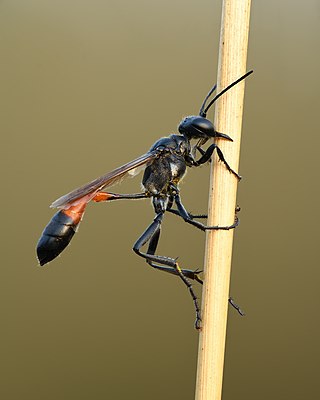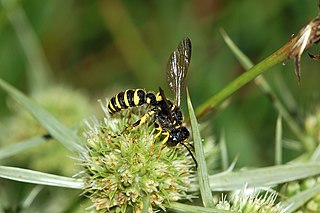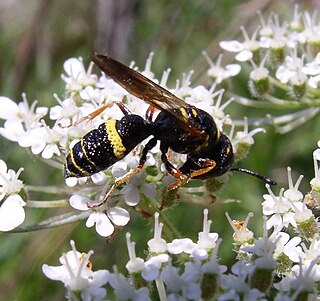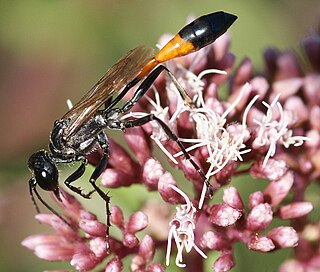
Dolichovespula maculata is a species of wasp in the genus Dolichovespula and a member of the eusocial, cosmopolitan family Vespidae. It is known by many colloquial names, primarily bald-faced hornet, but also including bald-faced aerial yellowjacket, bald-faced wasp, bald hornet, white-faced hornet, blackjacket, white-tailed hornet, spruce wasp, and bull wasp. Technically a species of yellowjacket wasp, it is not one of the true hornets, which are in the genus Vespa. Colonies contain 400 to 700 workers, the largest recorded colony size in its genus, Dolichovespula. It builds a characteristic large hanging paper nest up to 58 cm (23 in) in length. Workers aggressively defend their nest by repeatedly stinging invaders.

The Sphecidae are a cosmopolitan family of wasps of the suborder Apocrita that includes sand wasps, mud daubers, and other thread-waisted wasps.

Beewolves, also known as bee-hunters or bee-killer wasps, are solitary, predatory wasps, most of which prey on bees, hence their common name. The adult females dig tunnels in the ground for nesting, while the territorial males mark twigs and other objects with pheromones to claim the territory from competing males.

Bembix rostrata is a species of sand wasp native to Central Europe. The genus Bembix - of which B. rostrata is among the most distinctive species - has over 340 species worldwide and is found mostly in warm regions with open, sandy soils; Australia and Africa have a particularly rich variety of species.

The subfamily Philanthinae is one of the largest groups in the wasp family Crabronidae, with about 1100 species in 9 genera, most of them in Cerceris; Alexander treats it as having only 8 genera. Historically, this subfamily has frequently been accorded family status. The subfamily consists of solitary, predatory wasps, each genus having its own distinct and consistent prey preferences. The adult females dig tunnels in the ground for nesting.

The subfamily Crabroninae(digger wasps) is the most diverse group in the wasp family Crabronidae, containing over 110 genera and 4,800 described species. The subfamily consists of solitary, predatory wasps. The adult females of many groups dig tunnels in the ground for nesting, but others use different techniques, including the construction of tube-like mud nests.

Philanthus gibbosus, the hump-backed beewolf, is a species of bee-hunting wasp and is the most common and widespread member of the genus in North America. P. gibbosus is of the order Hymenoptera and the genus Philanthus. It is native to the Midwestern United States and the western Appalachians. P. gibbosus are often observed to visit flowers and other plants in search of insect prey to feed their young. The prey that P. gibbosus catches is then coated in a layer of pollen and fed to the young wasps.

A wasp is any insect of the narrow-waisted suborder Apocrita of the order Hymenoptera which is neither a bee nor an ant; this excludes the broad-waisted sawflies (Symphyta), which look somewhat like wasps, but are in a separate suborder. The wasps do not constitute a clade, a complete natural group with a single ancestor, as bees and ants are deeply nested within the wasps, having evolved from wasp ancestors. Wasps that are members of the clade Aculeata can sting their prey.

Ammophila is the type genus of the subfamily Ammophilinae of the hunting wasp family Sphecidae. Ammophila is a large and cosmopolitan genus, with over 200 species, mostly occurring in the warmer regions of all continents apart from Antarctica.

Ammophila sabulosa, the red-banded sand wasp, is a species of the subfamily Ammophilinae of the solitary hunting wasp family Sphecidae, also called digger wasps. Found across Eurasia, the parasitoid wasp is notable for the mass provisioning behaviour of the females, hunting caterpillars mainly on sunny days, paralysing them with a sting, and burying them in a burrow with a single egg. The species is also remarkable for the extent to which females parasitise their own species, either stealing prey from nests of other females to provision their own nests, or in brood parasitism, removing the other female's egg and laying one of her own instead.

Hunting wasps are members of various taxa of the insect order Hymenoptera. Their habits and affinities vary in many ways, but all practise parental care of their larvae in that they capture prey, usually insects, to feed their larvae. Whether solitary or social, most species construct some form of protection or nest in which they hide the prey and in which the larvae can feed and pupate in reasonable security.

Ammophila urnaria is a species of hunting wasp in the family Sphecidae. It is a black and red insect native to the eastern United States. It feeds on nectar but catches and paralyses caterpillars to leave in underground chambers for its developing larvae to consume.

Vespula atropilosa, also known as the prairie yellowjacket, is a black and yellow social wasp that forms annual colonies. Vespula atropilosa was formerly a member of the Vespa family. Males have either xanthic (yellow) or melanic (black) abdominal coloring. The prairie yellowjacket can be found in the Western and Midwestern United States as well as parts of southern Canada. It builds its nests underground and prefers large open areas such as pastures and golf courses. Vespula atropilosa colonies are founded by a queen in the spring and grow most during mid-summer. It preys on other insects such as flies and grasshoppers but is not a scavenger like other wasps. Queens mate with multiple males, and males will fight each other for matings. V. atropilosa is a social wasp that practices altruism. Prairie yellowjackets are not considered pests but are commonly found in backyards in the Pacific Northwest. This species derives its common name from the prairies and grasslands where it can be found.

Podalonia hirsuta is a species of parasitoidal wasps in the family Sphecidae.

Sphex funerarius, the golden digger wasp, is a species of digger wasp of the family Sphecidae.

Pison spinolae, commonly known as mason wasp, is a solitary wasp of the family Crabronidae, found throughout New Zealand.

Cerceris rybyensis, the ornate tailed digger wasp, is a Palearctic species of solitary wasp from the family Crabronidae which specialised in hunting small to medium-sized mining bees. It is the type species of the genus Cerceris and was named as Sphex rybyensis by Carl Linnaeus in 1771.

Ammophila placida is a species of thread-waisted wasp in the family Sphecidae. It is found in the continental United States and Central America.

Ammophila aberti is a species of thread-waisted wasp in the family Sphecidae.

Ammophila procera, the common thread-waisted wasp, is a species of thread-waisted wasp in the family Sphecidae. It is a common species, found in southern Canada, the United States, and Mexico, and south to Central America.



















